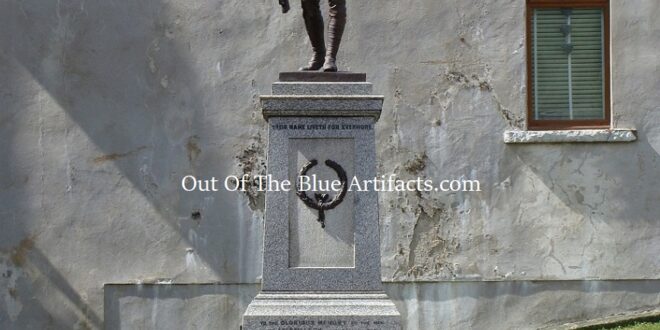Abertillery War Memorial.
After the Great War of 1914-1918 and prior to the erection of the War Memorial, the people of Abertillery attended Remembrance Day Services every November 11th at various buildings and locations in the town and surrounding area. The main procession for these services was formed at the Abertillery Drill Hall with a walk to the Parish Church where memorial services were held. The Salvation Army used to hold services at the Pavilion Theatre, Carlyle Street, the Tillery Institute Gymnasium and the Ebenezer Church, Abertillery.
The Abertillery monument isn’t of a unique design, it was sculpted by Mr George Thomas of Chelsea from an old design of his. The original is on the monument at Waterhead, Oldham, Manchester. The Waterhead statue was seen by Mrs A. H. Dolman whilst she was on a visit to Oldham, she asked the sculptor to submit the same design to the War Memorial Committee at Abertillery. Further information on the statue below.
The Proposal for a War Memorial.
On Monday 26th of January 1920, at the monthly meeting of the Abertillery Urban District Council held at the Council Chamber, Queen Street, Mr J. Morrell presided, the following members attended – Mr W. F. Walters (Vice-Chairman); Mr T. H. Mytton; Mr J. T. Boots; Mr D. Thomas; Mr H. Woodland; Mr L. Elliot; Mr J. Brown; Mr J. Carter; Mr J. Snellgrove; Mr R. Downs; Mr J. Mosger?; Mr J. Williams; Mr F. Athay; Mr A. Parry; Mr L. D. Lewis (Surveyor); Mr E. D. Wootten (Gas Manager and Engineer); Mr F. Padfield (Sanitary Inspector); Mr E. W. Jones (Accountant); Mr W. Gait (Clerk)and Mr D. R. Davies (Assistant Clerk):
At this meeting Mr Boots initiated a discussion upon the subject of a war memorial for Abertillery. He said, “The council should do something to perpetuate the memory of the many boys who had left the town and had fallen on the field of honour”. He went on to say, “I believe they went for the sake of freedom and it would be a disgrace to the town if they did not erect a suitable memorial to their memories”. “Some of the men had given their lives and a sculptured or other form of a memorial would be a sacred object of reverence”. Mr Woodland stated his objection and that he would be opposed to a monument but was in favour of a memorial in the shape of a public library, he wanted to know what form the monument would take before he recorded his vote for the principle. The resolution was seconded by Mr James Williams and carried. The council were to form a War Memorial Committee to discuss the matter.
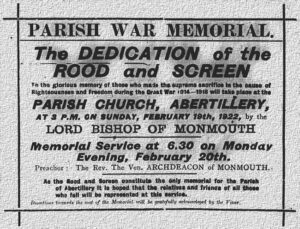 The Parish War Memorial.
The Parish War Memorial.
On Sunday 19th of February 1922, the Dedication of the Rood and Screen at the Parish Church, took place (as seen left). The service was conducted by the Lord Bishop of Monmouth. There was also a Memorial Service on the Monday evening of February 20th conducted by the Rev Ven Archdeacon of Monmouth. At this time it was stated that the Rood and Screen was the only memorial for the Parish of Abertillery. Souvenir booklets of the order of service were available at sixpence each.
The screens were of English oak, at its unveiling it was 24′ feet wide and 15′ feet high, with moulded mullions, the lower part of the openings filled with panelling and gates with panels traceried at top and inscribed with the names of more than 300 men of the parish who fell in the Great War. It was reported that when the screens were completed they would be continuous across the whole width of the church. Above the screen at a height of 21′ feet from the floor was the Rood Beam bearing the cross and figures of the Great Rood raising to a height of 44′ feet 6″ inches above the Nave floor. The figure of the Christ was 4′ feet 9″ inches and those of Our Lady and Saint John 4′ feet and 4′ feet 1″ inch respectively.
The Parish Church Rood Screen Contractor and Architect.
The screen was from the design of Mr J. Coates-Carter, architect of Prestbury, Gloucester and the work was carried out by Messrs Clarke & Sons, sculptors at Llandaff.
On Monday 25th of September 1922, at a monthly meeting of the Abertillery Urban District Council, the following members attended – Mr D. Thomas (Chairman); Mr J. Brown (Vice-Chairman) Mr L. Elliott; Mr W. Williams; Mr J. Lewis; Mr S. Pask; Mr G. Williams; Mr D. Smith; Mr J. T. Boots; Mr D. Walters; Mr J. Snellgrove; Mr F. W. Chivers; Mr T. H. Mytton; Mr F. Athay; Dr T. B. Smith (Medical Officer); Mr W. Gait (Clerk); Mr Hector Williams (Acting Assistant Clerk); Mr Ifor G. Jenkins (Gas Engineer); Mr M. J. Mortimer (Electrical Engineer); Mr L. D. Lewis (Surveyor); Mr R. Lewis (Accountant) and Mr F. Padfield (Sanitary Inspector): At this meeting the form that a memorial would take was debated.
Mr Boots referred to the King Street stables and that the Ambulance Brigade may acquire them as their premises. They suggested the brigade may have the old stables and the possibility of obtaining a motor ambulance, a way of remembering the fallen and yet helping the living. As finances were stretched, he had hoped people may give £1 for these objects. A week later a meeting a meeting was held at the Abertillery Council Chambers, to discuss the possibility of building a council chamber on the site of the old Oddfellow’s Hall on land between Queen Street and Somerset Street. Mr Thomas said, “The building would embrace many things such as council chambers, an ambulance hall and so forth”. The block of buildings would commemorate the brave men from Abertillery who fell in the Great War and also be of use to the living. Mr L. Elliott stated the scheme mentioned by Mr Thomas was too ambitious and would cost about £30,000.
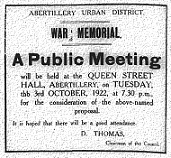 On Tuesday 3rd October a public meeting was held at Queen Street Hall, Abertillery in connection with the proposed war memorial.
On Tuesday 3rd October a public meeting was held at Queen Street Hall, Abertillery in connection with the proposed war memorial.
On Tuesday 24th of October 1922, at a meeting of the full council, Mr D. Thomas (Chairman) presided. Mr Thomas stated the war had been over nearly four years and Abertillery had no memorial. The town had experienced financial trouble with 2,000 or 3,000 unemployed since February 1921 and it was a very poor time to erect a memorial or anything else, but they thought the time had come to make a move in the right direction. He said he felt sure the people of Abertillery honoured the men who had made the supreme sacrifice as well as the men who came back, they would be glad of the opportunity to put on record their great sacrifices.
The council wanted an ambulance hall, they said it was more useful than a monument, they could ask for financial aid from the Miners Welfare Fund and use that money for a hall. Dr Cantlie spoke and said in his capacity as doctor he said the ambulance men of Abertillery were second to none and deserved a permanent building to practice in. More arguments arose and Mrs A. H. Dolman of the Women’s Citizens Association said the association wanted a monument, something similar to the one at Abergavenny.
Mr Phipps said the Aberbeeg ex-servicemen wanted a monument with a town clock. The Colliery Lodges stated their preference for an ambulance hall. Miss Jennie Gatfield of the Abertillery W. L. P. and Mrs Williams of the Llanhilleth and Aberbeeg W. L. P. advocated a children’s ward at the new hospital, they pointed out there were only two wards at present – Men’s and women’s.
Mr J. Phillips, with no mandate, suggested the ambulance men should have a building of their own but unconnected with any monument fund. He said the council had paid £1,000 for the Oddfellow’s Hall on Queen Street but hadn’t anticipated the financial conditions. He put forth the idea to purchase the old post office (later the Cottonwood Café) that would soon be vacant, the council could use it as a chamber and ambulance hall with a combined memorial. Mr Phillips was told that the old post office was situated too close to the train station and sidings making it to noisy to conduct municipal affairs.
Mr Little suggested a number of scholarships should be awarded to the children of the fallen soldiers, to give them a chance of being educated, though that idea was not taken in as it was stated any child who had the ability it could win a scholarship. After more delegates wanting a hall or council chamber Mr W. Phipps, in wanting to bring the room back down to earth told the council if they wanted a hall or some other public building, they must pay for it and let the old soldiers have what they want – A war memorial!
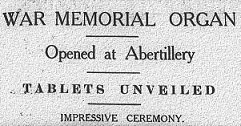 The Ebenezer Memorial Organ and Tablets.
The Ebenezer Memorial Organ and Tablets.
On Armistice Day 1922 the Ebenezer Baptist Church Memorial Organ and Tablets were unveiled (official notice left).
On Tuesday 21st of November 1922, a meeting of representatives of organisations in the Abertillery Urban District took place to consider the erection of a memorial to the men resident in the area who fell in the Great War. Chairman Mr D. Thomas stated, “It was not indifference on the part of the people, but rather the industrial trouble in the district which was responsible for the non-erection of a war memorial”. He said, “The past few meetings had shown there was unanimous decision in favour of some sort of memorial but there was a division of opinion on what form it should take”.
Mr A. Andrews of the Abertillery Branch of the British Legion said they, as ex-servicemen should have the first say on the matter. The ex-servicemen wanted a bronze monument on a granite base, on some suitable place in the town with a plaque attached to the monument with the names of the fallen. If there was any surplus money it should go towards the endowment of a bed in the hospital to be named after some battle in which local men were engaged. Mr E. Bevan of the then defunct “Penny Fund” also gave his backing for a permanent monument and in advocating it he would be acting in accord with the wishes of the thousands who had contributed their pennies to the fund.
Mr A. G. Little of the Vivian Colliery Lodge said they wanted an ambulance hall, failing that, a children’s bed in the hospital. He strongly opposed a monument or statue. Mr Max Parker of the Cwmtillery Colliery Lodge stated they were opposed to any war memorial in the district, he said “Any money should be spent on clothing and feeding the victims of the war instead of wasting it on useless bricks and mortar”. Mr W. Phelps of the Aberbeeg ex-servicemen was in favour of a visible memorial. Mr Elliott thought the general public should have a say and suggested that forms mentioning the various schemes should be sent out.
Mr Theo Evans urged the claims for an ambulance hall. Mr J. Snellgrove said his opinions had changed, he said he “Had recently stood before a monument and as he stood before it, it spoke to him” he went on to say, “If they were to have a monument it should be worthy of the sacrifices of the lads who had stepped into the breach in defence of their liberties”.
Mr James Jones of the Arael Griffin number 4 Colliery Lodge was another delegate to oppose any form of memorial. Mr W. J. Lawrence of the Gray Colliery Lodge spoke in favour of an ambulance hall. Mrs E. Wheeler of the Women’s Citizens Association though that any architectural form of building to be used as a monument would be “Neither here nor there”, the association wanted to see a monument standing silently alone making a strong sentimental appeal to passers-by to pause and contemplate the sacrifices of the fallen, a place where they could gather and pay tribute to the dead.
Mr J. H. Williams of the Llanhilleth Branch of the British Legion and Mrs Rees Williams of the Llanhilleth Women’s Labour Party favoured a memorial at Llanhilleth. The grocers representative Mr R. C. Morgan favoured a monument. Mr H. L. Berryman of the Boys Brigade favoured a war memorial with any surplus to be handed over for an ambulance hall. Mrs T. Adams of the Co-operative Women’s Guild said the guild had not met but the Women’s Labour Party were in favour of an ambulance hall. The tin works representative also wanted an ambulance hall. Councillor Mr T. H. Prichard of the Abertillery Chamber of Trade had no mandate though personally favoured a monument and thought they should give regard to the wishes of the ex-servicemen.
The chairman said that the municipal officer’s representative had asked him to express their preference firstly for a municipal building and secondly for a monument. He stated, “The meeting was in favour of a monument and the best way to prevent a repetition of the Great War was to put something up that would constantly remind them of it and its horrors”. Mr Theo Evans proposed a resolution on the lines suggested by the chairman. Mr Elliott and Mr Parker both thought the people should have a vote on the matter, Mr Andrews seconded. The chairman hoped the delegates would go back to their organisations and obtain their co-operation. The meeting was adjourned for a fortnight to deal with the question of the form and costs of a memorial.
On Tuesday 5th of December 1922, at a full meeting of the council held at the Abertillery Council Offices, Mr J. Brown the vice-chairman presided. Mr W. J. Lawrence of the Gray Colliery Lodge again objected to a monument and demanded a vote of the public should be taken. He was told by the vice-chairman that he was out of order as it was decided to erect a monument, the meeting was called only to consider the type of monument. The clerk read a letter from Messrs Humphries & Oaks of Bristol enclosing sketches and tenders for the erection of a monument, Mr A. G. Little suggested that the work be given to a local craftsman.
Mrs Wheeler thought the monument should be in the style of a cenotaph commemorating “those who fought” as well as “those who fell”. Mr W. Phipps apologised to disagree with the ladies but he preferred the monument commemorated the dead alone, he said, “The fallen were buried in France and gave their all for others”. Mrs Wheeler replied by reading the views of Mrs A. H. Dolman of the Women’s Citizens Association, which were – they were in favour of a monument conveying the idea of sacrifice rather than the spirit of the conqueror. Mr Bevan wanted a four-sided monument with brass plates on each side with the names of the fallen. Mr John Phillips suggested the setup of a committee to oversee the plans for recommendation. Mr D. Thomas the chairman arrived late just as a few arguments resurfaced over the need for an ambulance hall.
Mr Tho Evans stated that a cap of £500 be put on the final cost of any War Memorial. Mr Phillips wanted a cap of £400 with any remainder going towards an ambulance hall. Towards the end of proceedings a sub-committee consisting of Mr D. Thomas; Mr L. Brown; Mr Theo Evans; Mrs Wheeler; Mr John Phillips; Mr Edgar Bevan; Mr William Baynton; Mr W. J. Lawrence and Mr A. G. Little was set up to deal with the design, placement and siting of the memorial.
On Sunday 22nd of July 1923, the 4th annual Memorial Service was held at the Parish Church.
War Memorial Siting Meeting.
On Monday 29th of October 1923, at a monthly meeting of the Abertillery Urban District Council, the following members attended – Mr James Brown (Chairman); Mr T. H. Mytton (Vice-Chairman); Mr L. Elliott; Mr W. Williams; Mr J. Snellgrove; Mr W. F. Walters; Mr J. Lewis; Mr G. Williams; Mr Richard Tudor; Mr D. Smith; Mr D. Thomas; Mr D. Walters; Mr H. J. Davies; Mr F. Athay; Mr J. T. Boots; Mr F. W. Chivers; Mr J. H. Godwin; Mr W. Gait (Clerk); Mr D. R. Davies (Deputy Clerk); Mr R. Prosser (Accountant); Mr F. J. Mortimer (Electricity Works Manager); Mr Ifor G. Jenkins (Gas Works Manager); Mr A. G. Jones (Surveyor); Mr F. Padfield (Sanitary Inspector); Mr T. B. Smith (Medical Officer) and Mr D. E. Williams (Superintendent Assistant Overseer): At this meeting the siting of the war memorial was discussed.
The Chairman, Mr Brown referred to the suggested site of the proposed war memorial in the park at Abertillery. Mr Boots moved and Mr Athay seconded that a different site be chosen, he said the committee had been all around the town looking at possible sites and had come back to the park, the spot they selected was close to the bandstand and very convenient. Mr Boots objected to placing the memorial anywhere in the park as it would not be seen by more than one per cent of the population of the town. Mr Thomas also objected to the site at the park. Mr Snellgrove suggested Division Street, though Mr Athay strongly opposed to a site in Division Street! He said, “If there’s a meeting place for Revolutionaries in Abertillery it’s in Division Street”. Chairman, Mr Brown responded by saying “It would be impossible to put the monument at Division Street” and Mr Athay said the best place would be the Abertillery Park.
Mr Chivers, the ex-servicemen’s representative asked what was the objection to a piece of ground at the end of Queen Street? It was council property and should be better cared for. The spot mentioned was a general promenade and a monument there would be well in the public eye. Mr Brown responded by saying that the committee thought the site at Queen Street was out of the way, not many people passed that location. The clerk suggested a special meeting should be held to select a site, failing that, the Abertillery Park site should be resorted to.
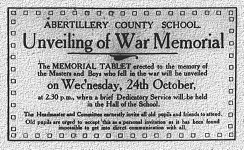 The County School Memorial.
The County School Memorial.
On Wednesday 24th of October 1923, the Memorial Tablet was unveiled at the Abertillery Intermediate County School (as seen right). The memorial was erected in the memory of the masters and boys who fell in the Great War. The tablet was of a plain design yet dignified, at the head it had a wreath encircling the words “Our Glorious Dead”, it contained the names of three masters and 24 boys who had sacrificed their lives.
The Abertillery War Memorial Form and Site Decided.
On Wednesday 21st of November 1923, at a meeting of the War Memorial Committee at the Council Chambers, Abertillery, it was resolved to erect a granite memorial on ground near the Queen Street Schools and to raise a 25,000 shillings fund to meet the costs. Mr James Brown the chairman spoke of his regret that a site was not chosen at the Abertillery Park but then appealed that they should go ahead with the scheme with real earnestness for he believed that everyone felt that they, as a town had not done their duty in commemorating the brave men who had sacrificed their lives in the war.
Mr Brown went on to say that every town and even small hamlets had some sort of memorial and a town like Abertillery with a population of over 40,000 should not be the last to pay honour to its glorious dead. There were rumours that the Tillery Collieries were to have their own monument erected at the town though Mr L. Elliott said he had not heard of this and that it was just a rumour. Mr Elliott wanted the memorial sited at Church Street, on land near the church, (where Jubilee Square is today) other committee members gave their opinions on suitable sites. The Women Citizens said they wanted a granite cenotaph like the one at Whitehall, they said Abertillery had a mineral atmosphere and not the ordinary country air, the monument had to be robust to last a hundred years.
Mrs A. H. Dolman who spoke for the Women’s Citizens Association agreed that Queen Street was a suitable site though suggested that they take a look at a piece of ground behind the British Central Schools, a prominent site overlooking the railway. Other sites were debated, opposite the Bush Hotel and more proposals for the Church Street site. It was stated there had been problems with the scheme owing to the continual changes in the membership of the committee and the following were elected – Mr J. Brown was appointed (Chairman); Mr Edgar Bevan and Mr F. W. Chivers (Vice-Chairmen); Mr W. Gait and Mr D. R. Davies (Joint Secretaries) and Mrs A. H. Dolman (Treasurer):
Mr Boots told of the creation and importance of the 25,000 shillings fund which would provide £1,250 and people could contribute as much as they liked. Mr Boots said he would give fifty shillings. The committee adjourned to the surveyor’s office where Mr Gordon Jones produced a model of the proposed monument that was made by Mr Lionel D. Lewis, the former surveyor of the Abertillery District Council. It was decided that the monument be made of granite and the design be chosen at a later meeting.
In January 1924 the War Memorial Committee held a meeting with the object of exploring the various ways of raising funds. Mr James Brown presided and the other members of the committee were as follows – Mr J. Williams; Mr T. H. Prichard; Mrs A. H. Dolman (Treasurer); Mrs Athay; Mrs T. Adams; Miss A. Gregory; Mr J. Harding; Mr W. Morgan; Mr A. G. Little. Mr P. Williams; Mr John Phillips; Mr Richard Tudor; Mr F. W. Chivers; Mr D. R. Davies; Mr A. G. Jones; Mr A. S. Baker; Mr W. Gait and Mr Hector Williams (Joint Secretaries): It was agreed to appoint a committee in each of the four wards to be responsible for a house-to-house collection and the following were chosen – Mrs Wearn & Mr F. W. Chivers for Cwmtillery. Mrs Athay & Mrs Adams for Blaenau Gwent. Miss Gregory & Mr John Phillips for Town and Mr Barker & A. Hammond for Six Bells.
Mr Lionel Falkman.
Fund raising got under way and many benefit concerts were held in the various theatres in town, Mr Lionel Falkman appeared at the Abertillery Metropole Theatre courtesy of the Capitol Theatre, Cardiff.
Fake Fundraisers.
It was reported that there were problems with the fund raising at the Powell’s Tillery Institute, someone had reported back to the War Memorial Committee that their fund raisers were ejected from the institute for not having permission to be in the building.
This, as harsh as it may seem, was correct and well founded as the men at the institute feared wrongdoing and stopped anyone entering with the intent to gain funds in connection with the War Memorial, as in February 1924 a young local man, aged 24 appeared in court charged with obtaining money by deception by claiming he was fund raising for the War Memorial Tablet at the institute. The committee at the institute denied there was any fund raising at the institute. The official fund-raising committee postponed any money collections until they made and distributed official “Fund Raising Identification Cards” to the fund raisers.
In March 1924 the War Memorial Committee met and Mrs Dolman of the Women’s Citizens Association stated she had visited London and whilst there had made enquiries of Mr George Thomas, a sculptor, in regard to a monument erected at Waterhead, Oldham. The monument there depicted a soldier in fighting kit leaving the trenches. Mrs Dolman was requested to obtain full particulars for submission to a future meeting.
In August 1924 it was reported that 13,084 shillings were in the Abertillery War Memorial Shilling Fund.
On Tuesday 7th of October 1924, a meeting of the General Purposes Sub-Committee in connection with the siting of the war memorial was held at Queen Street Hall. Members of the committee were not in favour of the siting of the memorial at Queen Street and wanted to have it changed to another place. Mrs Dolman (Treasurer) said there was £655. 10s. 2d. in the fund though stated no more money was coming in and the people were getting fed up with the bickering over the site for the memorial. The committee said the majority of the people wanted a site at the Abertillery Park and they must have a say in the final decision, it was resolved to get a public vote on the subject.
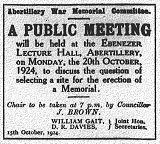 On Monday 20th of October 1924, a public meeting was held at the Ebenezer Lecture Hall, Abertillery. The meeting was held for the purpose of selecting a site for the war memorial. Mr James Brown J.P. presided and was supported by Mrs A. H. Dolman, Mr E. Bevan, Mr W. Gait and Mr D. R. Davies. Mr A. Gordon Jones the surveyor, stated the cost to prepare the Queen Street site was between £500 to £550 for preparing the site at the park was £150 to £200. All the sites that were mentioned previously was debated again, the main reason the Abertillery Park site was not looked upon favourably was the danger that it could be damaged or vandalised. The site located opposite the Abertillery Post Office and the Bush Hotel was raised though the council stated there was a urinal built there and it would cost up to £800 to remove and re-site it elsewhere. Towards the end of the meeting three votes were conducted which resulted in a unanimous decision to have the memorial sited at Queen Street.
On Monday 20th of October 1924, a public meeting was held at the Ebenezer Lecture Hall, Abertillery. The meeting was held for the purpose of selecting a site for the war memorial. Mr James Brown J.P. presided and was supported by Mrs A. H. Dolman, Mr E. Bevan, Mr W. Gait and Mr D. R. Davies. Mr A. Gordon Jones the surveyor, stated the cost to prepare the Queen Street site was between £500 to £550 for preparing the site at the park was £150 to £200. All the sites that were mentioned previously was debated again, the main reason the Abertillery Park site was not looked upon favourably was the danger that it could be damaged or vandalised. The site located opposite the Abertillery Post Office and the Bush Hotel was raised though the council stated there was a urinal built there and it would cost up to £800 to remove and re-site it elsewhere. Towards the end of the meeting three votes were conducted which resulted in a unanimous decision to have the memorial sited at Queen Street.
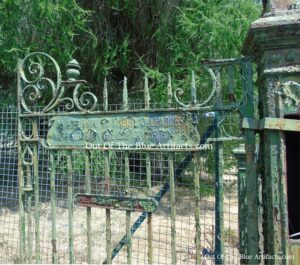 Aberbeeg Memorial Gates.
Aberbeeg Memorial Gates.
On Saturday 13th of December 1924, the Memorial Gates at Aberbeeg Hospital (as seen right) were officially unveiled. The gates were to commemorate the council staff members who fell in the Great War.
They were made by Messrs Bayliss, Jones & Bayliss of Wolverhampton at a cost of £140 and was erected by Mr Robert Coulston Jones a builder of 11 Duke Street, Abertillery under the supervision of Mr A. Gordon Jones, Surveyor to the Abertillery District Council.
In February 1924 Mr W. Gait and Mr D. R. Davies both announced their resignations from the War Memorial Committee owing to pressure from their other duties and in March Mr James Brown J.P. (Chairman) also resigned from his duties stating his failing health as a reason. Mr F. W. Chivers and Mr E. Bevan were elected to the chair. I am not sure if they were later reassigned to the committee though their names appeared in later reports!
Abertillery Flag Sellers.
In May 1925 the Abertillery Division of Women Unionists Association announced that they had held a Flag Day resulting in the collection of £17. 4.s 6d. for the Abertillery War Memorial. The flag sellers were as follows – Misses Betty Clayton; Evelyn Phillips; Ruby Joslyn; Lizzie Hutchins; Blodwen Morgan; Gwen Morgan; Connie Cleaton; Dorothy Barnes; Maggie Thomas; Connie Wessendorff; Doreen Williams; Ina Frowen; Olwen Thomas; Margery Hiley; Winnie Smith; Enid Flowers; Edna Coles; Cissie Hathaway; Dorothy Naish; Violet Coles; Marion Collett; Annie Skein; Violet Watkins; Edna Joseph; Ida Williams; Edna Swansbury; Muriel Meredith; J. Collins and D. Harvey:
In February 1926 it was reported that 23,063 shillings were in the Abertillery War Memorial Shilling Fund, amounting to £1,153. 3s. 0d. A donation of $71 dollars = £14. 11s. 7d. was sent from former Abertillery families living in America, the donations were forwarded to the fund via Mrs Elizabeth Stephens Cross, of Dormont, P.A. U.S.A. It was stated all subscriptions were to be sent to Mrs A. H. Dolman of Dunmore House, Oak Street, Abertillery.
The Statue.
On Thursday 4th of March 1926, Mr J. T. Boots presided over a meeting of the War Memorial Committee, held at the Council Chambers, Queen Street. Mr Boots confirmed that they had correspondence from Sculptor Mr George H. Thomas of Chelsea, it was noted that the cost of the statue had been reduced from £400 to £350. The committee decided to place the order and the statue which represents a soldier in fighting kit raising his helmet in greeting would be mounted on a pedestal and erected on the ground at the junction of Queen Street and Somerset Street. The committee said they would endeavour to obtain the services of Sir Douglas Haig to perform the unveiling ceremony.
On Thursday 17th of June 1926, Mr F. W. Chivers presided over a meeting of the War Memorial Committee, held at the Council Chambers, Queen Street. Mr A. Gordon Jones the surveyor, submitted a report on the proposed memorial and stated the total cost would be £1,311. 5s. 0d. The site at the junction of Queen Street and Somerset Street was an awkward one and they had to make the best of it. Mrs Dolman reported there was £1,252. 14s. 6d. in the fund and that they were within £50 of the total amount required. It was also reported that the War Memorial Committee issued notices that the final plans were being prepared for the names of the fallen to be inscribed on the plaques that were being attached to the memorial, they were keen to see no-one was left off the list and invited anyone with a relative who they lost in the conflict to inspect the list that had been written out and was on show at the Council Chambers at the Oddfellow’s Hall, Abertillery.
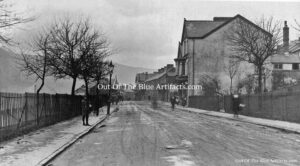 The Final Preparations.
The Final Preparations.
In September 1926 it was reported that the work on the memorial site (as seen right) was making good progress, the work was being done by the council under the supervision of Surveyor Mr A. Gordon Jones, the costs would be defrayed by the fund. The inscription chosen for the memorial was “To the Glorious Memory of the Men of Abertillery who fell in the Great War 1914-1918”. “Greater love hath no man than this, that a man lay down his life for his friends” (John 15.13.). On the opposite side was “Their name liveth for ever”.
The List of Names to be Included on the Monument.
Letters were read from General Smith-Dorrien and Sir Robert Baden-Powell expressing their regret that they would be unable to unveil the memorial but Field-Marshall Lord Allenby wrote accepting the invitation to attend on the 1st of December 1926. Mr D. R. Davies the secretary said 390 names had been received for inscription on the memorial, 261 with a rank and 129 without, it was agreed that further steps were to be taken to ensure no-one was to be left out.
Early Vandalism.
November 1926 preparations were put in force for the unveiling and souvenir programmes were printed and sold at 3d. each. The surveyor had reported to the council that children had damaged the memorial site and requested that the education authority to ask the head teachers to lecture the children on the sacredness of the memorial and to appeal to ministers of religion to refer to the matter from their pulpits. Owing to the damage being caused to the memorial and theft of materials from the site a night-watchman was employed by the council.
Towards the end of November 1926, the War Memorial Committee requested the schools in Abertillery from Cwmtillery to Six Bells should grant the children half a day holiday for the unveiling of the war memorial. They also asked for the use of Queen Street School in case the weather was unfavourable.
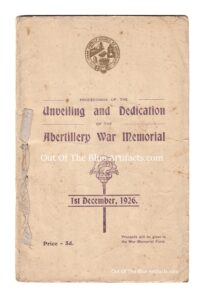 The Unveiling of the Memorial.
The Unveiling of the Memorial.
On Wednesday 1st of December 1926, the Abertillery War Memorial was unveiled to the public. Field Marshall Viscount Allenby G.C.B., G.C.M.G. was asked to perform the ceremony.
The party left the Bush Hotel, went up Bush High St and across Somerset St to the Monument. The party included The Abertillery Fire Brigade, Women’s branch of the British Legion, Women’s Nursing Division, Ambulance Brigade, Lord Allenby, Mr George Barker, Mr William Brace and hundreds of other dignitaries, too numerous to write though individual names can be produced by request.
Details of the Memorial Statue.
The statue measured 6′ feet 2″ inches high including a base of 3″ inches and mounted on a pedestal of grey Cornish granite 7′ feet 10″ inches high by 3′ feet 10″ inches wide and panelled on all 4 sides. The front of the monument had a bronze wreath while the other three sides had bronze tablets containing names and regiments of the fallen. The pedestal and steps were supplied by Messrs Walter Bryant & Co of Bristol from their Cornish quarries. The bronze figure of a soldier was sculpted by Mr George Thomas of Chelsea from a design which he had previously submitted and sculpted for the village of Waterhead, Oldham, Manchester.
The service was held by the vicar of Abertillery Rev. W. L. Harris, chaplain to the Abertillery branch of the British Legion, as Viscount Allenby unveiled the statue, four soldiers in fighting kit (one on each corner of the monument) that had been like statues themselves throughout the ceremony sprang to attention and the Union Jack came from the monument. The whole guard of honour presented arms and the Last Post and Reveille was sounded by the buglers of the 3rd Battalion Monmouth Regiment. The Rev A. Snadow of the Jewish Synagogue then read scripture and offered prayer. The was a two-minute silence with all the assembled troops at attention.
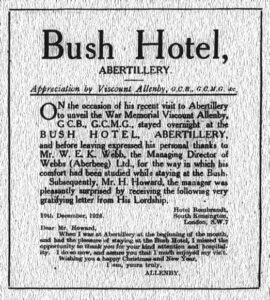 The party went back to the Bush Hotel for lunch.
The party went back to the Bush Hotel for lunch.
After the unveiling ceremony there were reports that the council had received threats that certain people in the area who were aggrieved that the Abertillery War Memorial was not sited at the Abertillery Park, planned to cause damage and destruction to the monument. In response to these threats the council in addition to the night-watchman asked for an extra police presence to patrol Queen Street and the war memorial.
The New Railings Bordering the Memorial.
On Friday 5th of July 1946, the South Wales Gazette issued a statement that the council, under the War Memorials (Local Authorities Powers) Act, 1923, wanted to provide dwarf ornamental iron railings at the War Memorial at Somerset Street, Abertillery to replace the badly cracked balustrading which was beyond repair. Mr H. J. Williams,(Clerk of the Council).
The New Name Panels Proposal.
Shortly after the second world war, the names of those who died in that conflict needed to be placed on the war memorial. The Abertillery Urban District Council War Memorial Committee were anxious to obtain a full list of names, ranks, regimental numbers and honours of all men who died in the war and posted requests in local papers.
The Fixing of the New Name Panels.
On Friday 8th of October 1954, the South Wales Gazette reported on the fixing of the new name panels to be added onto the Abertillery War Memorial, these new panels contained the names of those who made the supreme sacrifice in the 1939-1945 World War. It stated the new panels would be unveiled on Sunday 7th of November 1954.
The Unveiling of the New Name Panels Ceremony.
On Friday 12th of November 1954 the South Wales Gazette ran the story of the unveiling of the new name panels the previous Sunday. The unveiling ceremony was conducted by Lord Lieutenant, Lord Raglan and was described as one of the largest parades of local organisations ever seen in the town. Captain W. J. Snelgrove M.B.E., and Mr A. Gordon Jones both heralded the impressive proceedings at the memorial where Councillor Idris Pope J.P. Chairman of the Abertillery Town Council presided. Rev T. Glanville Jones B.A., B.D., M.Th., led the devotions.
The new panels were dedicated by Canon T. Madog Williams B.A., Rural Dean of Blaenau Gwent, Chaplain to the Chairman of the Abertillery Council. The Parade was led by the band of the 3rd Mon Regiment, included Lord Raglan and others too numerous to mention. The service was conducted by Canon Madog Williams and Rev Leslie Stephenson and the reading was by Major Gen T. W. Rees C.B., C.I.E., D.SO., M.C., LL.D., President of the Burma Star Association. Rev Leslie Stephenson gave an impressive address based on the text “Be strong and good courage” (Joshua 1:6.)
The Maintenance of the War Memorial.
On Thursday 8th of December 1983, the Gwent Gazette reported – Blaenau Gwent Borough Council and Abertillery Town Council had reached an agreement on the maintenance and upkeep of the Abertillery War Memorial. In a letter to the Borough Council’s Director of Leisure, Mr David Nash, the Town Council Clerk, Mr Gwyn Price, said following the meeting with the chairman and vice-chairman of the Borough Council’s Leisure and Amenities Committee, it was decided that the Abertillery Town Council retain responsibility for the Abertillery War Memorial, surrounding ornamental stone-work and gates, with the Borough Council being responsible for the maintenance of the flower borders and grassed area.
Source – The South Wales Gazette.
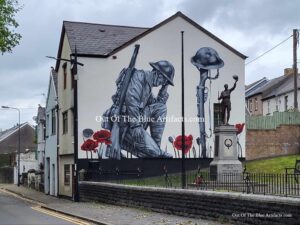 The Mural.
The Mural.
In September 2023 a mural (as seen in the image left) was commissioned from public contributions, to be painted on the pine-end of the house directly behind the War Memorial at Abertillery. The whole project was organised by local businessman Bob Smith.
The wall was rendered, painted and prepared for the artwork consisting of a soldier on one knee in front of the grave of a fallen comrade, marked by a rifle and helmet, flanked by poppies. The artist was Tee2Sugars of South Wales.
Points of Interest – The statue is not unique, in as much as it is an exact copy of another war memorial. As stated above, in March 1924 the War Memorial Committee met and Mrs Dolman of the Women’s Citizens Association stated she had visited London and whilst there had made enquiries of Mr George H. Thomas, a sculptor from Chelsea, in regard to a monument he had sculpted and erected at Waterhead, Oldham, Manchester. The pedestal and steps were supplied by Messrs Walter Bryant & Co of Bristol from their Cornish quarries.
Mr George Havard Thomas.
Mr George Havard Thomas, the sculptor of the war memorial Abertillery was born on 9th May 1893 at Sorrento, Italy. The son of Mr James Havard Thomas and an Italian mother by the name of Sofia. Mr George H. Thomas attended Clifton College and worked with his father as well as studying under him at the Slade School between 1914 and 1915 and 1919 and 1920. During the Great War he served as an officer, a captain and was awarded the Military Cross. In 1920 he was assistant lecturer at the Slade School and taught there until his death in 1933.
The information on Mr George Havard Thomas was kindly supplied courtesy of Mr Simon Blackmore of Marcham, Oxfordshire, England.
As stated, Mr George Havard Thomas was contracted to make the Abertillery War Memorial from the same design as the memorial that he also sculpted at Waterhead, Oldham, Manchester. He also sculpted another war memorial at Newhey, Milnrow, Rochdale, Lancashire, England. The latter was of a different design from the other two.
 Out Of The Blue Artifacts A Library of a lifetime of collecting
Out Of The Blue Artifacts A Library of a lifetime of collecting
